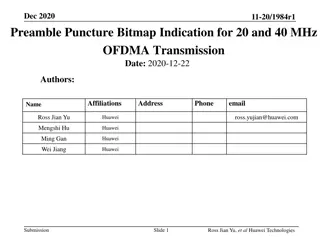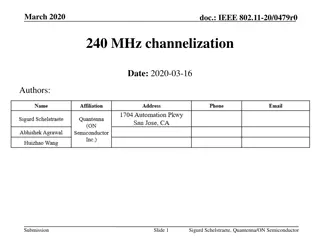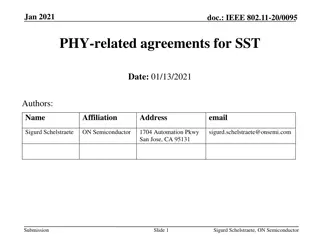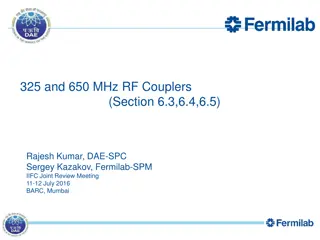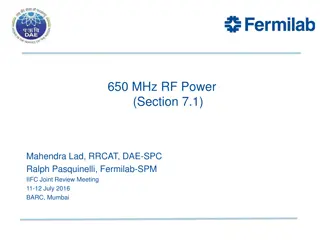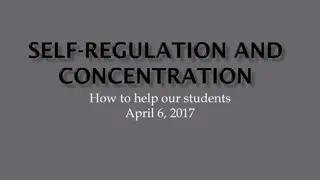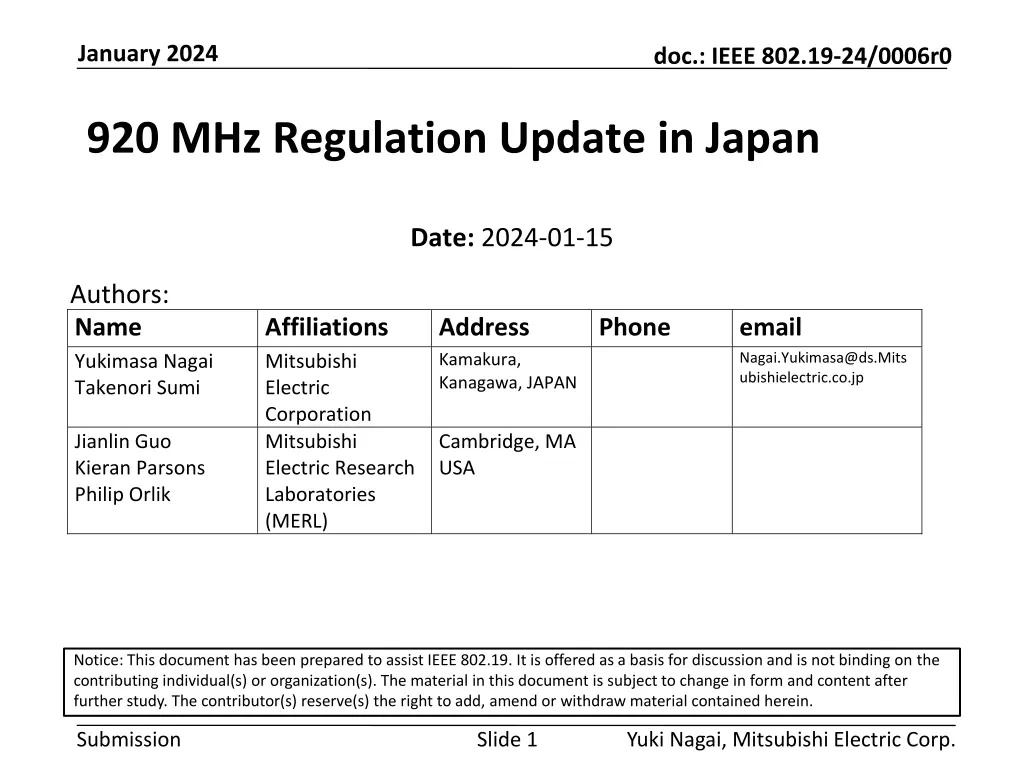
IEEE 802.19-24 January 2024 Document on 920MHz Regulation Update in Japan
Explore the latest updates in Japan's 920MHz regulation as discussed in the IEEE 802.19-24 document of January 2024. Gain insights into channelization, coexistence operations, current use cases, and more related to wireless systems in Japan.
Download Presentation

Please find below an Image/Link to download the presentation.
The content on the website is provided AS IS for your information and personal use only. It may not be sold, licensed, or shared on other websites without obtaining consent from the author. If you encounter any issues during the download, it is possible that the publisher has removed the file from their server.
You are allowed to download the files provided on this website for personal or commercial use, subject to the condition that they are used lawfully. All files are the property of their respective owners.
The content on the website is provided AS IS for your information and personal use only. It may not be sold, licensed, or shared on other websites without obtaining consent from the author.
E N D
Presentation Transcript
January 2024 doc.: IEEE 802.19-24/0006r0 920 MHz Regulation Update in Japan Date: 2024-01-15 Authors: Name Yukimasa Nagai Takenori Sumi Affiliations Mitsubishi Electric Corporation Mitsubishi Electric Research Laboratories (MERL) Address Kamakura, Kanagawa, JAPAN Phone email Nagai.Yukimasa@ds.Mits ubishielectric.co.jp Jianlin Guo Kieran Parsons Philip Orlik Cambridge, MA USA Notice: This document has been prepared to assist IEEE 802.19. It is offered as a basis for discussion and is not binding on the contributing individual(s) or organization(s). The material in this document is subject to change in form and content after further study. The contributor(s) reserve(s) the right to add, amend or withdraw material contained herein. Submission Slide 1 Yuki Nagai, Mitsubishi Electric Corp.
January 2024 doc.: IEEE 802.19-24/0006r0 Abstract Share the new 920MHz regulation (Issued: Sep. 2022) [5][6] status in Japan towards Recommended Practice in IEEE 802.19.3a This document gathers relevant material from 19-18/0053r0, 19-18/0084r0 and 19-19/0018. Submission Slide 2 Yuki Nagai, Mitsubishi Electric Corp.
January 2024 doc.: IEEE 802.19-24/0006r0 Channelization in Japan Several wireless systems operate on same frequency band which were standardized as ARIB STD-T106, T107 and T108 ARIB STD-T108 (20mW) on 920.5 ~ 928.1MHz (7.6MHz) includes 802.15.4g system, but coexistence operation with Passive System (250mW) and STD-T108 (250mW) is required for 920.5 ~ 923.5MHz (3.0MHz). So, 923.5 ~ 928.1MHz (4.6MHz) is only channels Coexistence Operation Passive System (RFID, etc) 1W ARIB STD-T106 Licensed/Registered MCA 250mW ARIB STD-T107 Unlicensed 923.4 920.6 919.2 929.65 916.0 928.0 MHz 1mW ARIB STD-T108 Unlicensed 20mW ARIB STD-T108 Unlicensed IEEE802.15.4g, etc 250mW ARIB STD-T108 Licensed/Registered Active System (LPWA, 802.15.4g, etc) Ch: 200KHz Channels for sensor networks Ch: 100KHz MCA: Multi-Channel Access Radio System Submission Slide 3 Yuki Nagai, Mitsubishi Electric Corp.
January 2024 doc.: IEEE 802.19-24/0006r0 [1][2][3] Current Use Cases Current use cases in the market for each wireless system*1. Specified Low-Power Radio Station use case is the most likely one to require 802.15.4g and 802.11ah*2 coexistence measures Indoor Radio Station (Licensed/Registered, Passive System) Tx Power: 1W Frequency: 916.7~920.9MHz Use Cases: RFID for Logistics Management, etc ARIB STD-T106 Specified Low-Power Radio Station (Unlicensed, Passive System) Tx Power: 250mW Frequency: 916.7~923.5MHz Use Cases: RFID for inside/outside ARIB STD-T107 Specified Low-Power Radio Station (Unlicensed, Active System) Tx Power: 20mW Frequency: 920.5 ~ 928.1MHz Use Cases: Smart Mater (Electric, Gas, Water), etc ARIB STD-T108 Land Mobile Station (Licensed/Registered, Active System) Tx Power: 250mW Frequency: 920.5 ~ 923.5MHz Use Cases: LPWA for sensors (forest, bridge, etc) ARIB STD-T108 Specified Low-Power Radio Station (Unlicensed, Active System) Tx Power: 1mW Frequency: 915.9 ~ 929.7MHz Use Cases: Home Security, Remote Control ARIB STD-T108 *1: MIC is going to deregulate the current standard to meet the future use cases (Inside/Outside, Tx Time, Duty Cycle, etc)[3] *2: IEEE 802.11ah is not specified on ARIB STD-T108 at this moment [2] Submission Slide 4 Yuki Nagai, Mitsubishi Electric Corp.
January 2024 doc.: IEEE 802.19-24/0006r0 [3][4] ARIB STD-T108 (20mW) Specified Low-Power Radio Station (Unlicensed, Active System)* Item Parameters and functionality Frequency Band 920.5MHz ~ 928.1MHz (7.6MHz) 920.5 ~ 923.5 MHz (3.0MHz) --- Coexistence with others 923.5 ~ 928.1 MHz (4.6MHz) --- Channel for STD-T108 Channel bandwidth 200KHz 5 CHs (1MHz) 920.5 923.5 MHz: 15 CHs (4MHz) with CS and Duty Cycle rule [5][6] 920.5 928.1 MHz: 20 CHs (4MHz) with CS and Duty Cycle rule [5][6] Maximum aggregated channels Transmission Power 20mW (13dBm) Transmission method Contents Data signal Modulation Not specified Antenna Gain 3dBi or less (absolute gain). However, in case EIRP is less than the value of 3dBi plus 1mW or 20mW of antenna power, it is allowed to fill in the gap by the antenna gain CS 5msec, 920.5 ~ 923.4 MHz 4sec, 50ms Carrier Sense (CS) and Duty Cycle Tx Time Wait 5msec > CS 128us 920.5 ~ 928.1 MHz 400ms, 2ms, Tx Time Wait Total Tx Time 360s/h/station Note Refer IEEE 802.15.4g for PHY parameters *: MIC is going to deregulate the current standard to meet the future use cases [3] [5][6] define new channel bandwidth up to 4 MHz which issued in Sep. 2022. Submission Slide 5 Yuki Nagai, Mitsubishi Electric Corp.
January 2024 doc.: IEEE 802.19-24/0006r0 Duty Cycle for Active System Each specified low-power radio station can transmit radio signal for at most 360 seconds/hour in the current 920MHz regulation. [3] MIC (Ministry of Internal Affairs and Communications) is considering relaxing the current duty cycle regulation: o When a specified low-power radio station use multiple channels in time division, duty cycle is 720 seconds/hour. o Duty cycle of each channel is 360 seconds/hour/station. Total Tx Time 360sec. Per station 360sec. Deregulation of Duty Cycle Current regulation Total Tx Time 360sec. Per station 360sec. Using single channel Using single channel 360 sec. 360 sec. 360 sec. 360 sec. Time Time 3600 seconds 3600 seconds Using multiple channels Using multiple channels 100 sec. 120 sec. 720 sec. 160 80 360 sec. 100 90 80 350 Time Time 3600 seconds 3600 seconds Yuki Nagai, Mitsubishi Electric Corp. Submission Slide 6
January 2024 doc.: IEEE 802.19-24/0006r0 Summary 802.15.4g specified on ARIB STD-T108 (20mW) can operate on o 920.5 ~ 928.1MHz (7.6MHz) , but 920.5 ~ 923.5MHz (3.0MHz) --- Coex. with Passive Systems and LPWA 923.5 ~ 928.1MHz (4.6MHz) --- Channel for sensor nets MIC had extended the maximum channel numbers from 5 CHs (1MHz) to 20 CHs (4MHz) to support IEEE 802.11ah in 2022 We would like the IEEE 802.19.3a to consider coexistence between 802.15.4g and 802.11ah under the conditions and operational constraints noted above on Recommended Practice. Submission Slide 7 Yuki Nagai, Mitsubishi Electric Corp.
January 2024 doc.: IEEE 802.19-24/0006r0 References 1. MIC, http://www.soumu.go.jp/main_content/000544861.pdf, 2018/04/10 2. MIC, http://www.soumu.go.jp/main_content/000550848.pdf, 2018/05/14 3. MIC, http://www.soumu.go.jp/main_content/000551143.pdf, 2018/05/15 4. https://www.arib.or.jp/english/html/overview/doc/5-STD-T108v1_0-E1.pdf 5. MIC, https://www.soumu.go.jp/main_content/000833183.pdf 6. MIC, https://www.soumu.go.jp/main_content/000833184.pdf MIC (Ministry of Internal Affairs and Communications) Submission Slide 8 Yuki Nagai, Mitsubishi Electric Corp.

